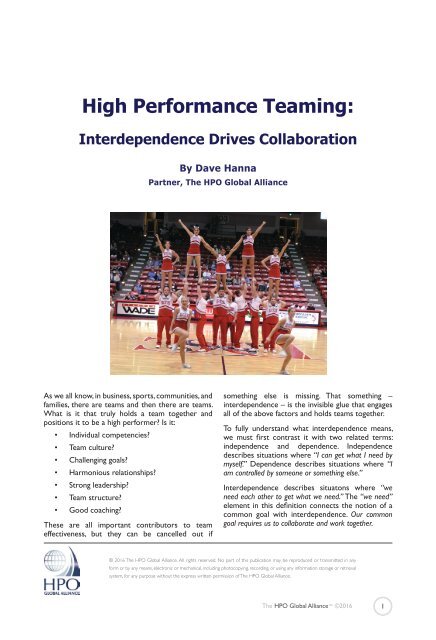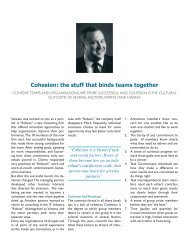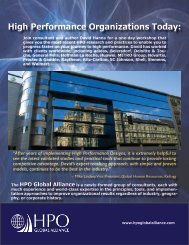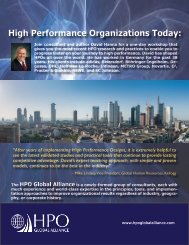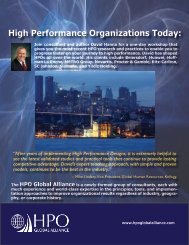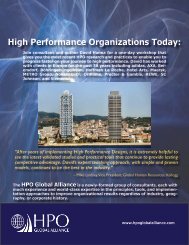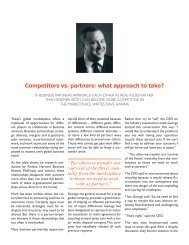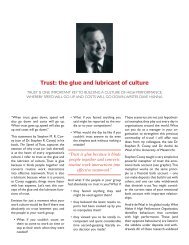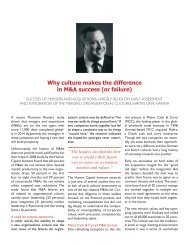High Performance Teaming
You also want an ePaper? Increase the reach of your titles
YUMPU automatically turns print PDFs into web optimized ePapers that Google loves.
<strong>High</strong> <strong>Performance</strong> <strong>Teaming</strong>:<br />
Interdependence Drives Collaboration<br />
By Dave Hanna<br />
Partner, The HPO Global Alliance<br />
As we all know, in business, sports, communities, and<br />
families, there are teams and then there are teams.<br />
What is it that truly holds a team together and<br />
positions it to be a high performer? Is it:<br />
• Individual competencies?<br />
• Team culture?<br />
• Challenging goals?<br />
• Harmonious relationships?<br />
• Strong leadership?<br />
• Team structure?<br />
• Good coaching?<br />
These are all important contributors to team<br />
effectiveness, but they can be cancelled out if<br />
something else is missing. That something –<br />
interdependence – is the invisible glue that engages<br />
all of the above factors and holds teams together.<br />
To fully understand what interdependence means,<br />
we must first contrast it with two related terms:<br />
independence and dependence. Independence<br />
describes situations where “I can get what I need by<br />
myself.” Dependence describes situations where “I<br />
am controlled by someone or something else.”<br />
Interdependence describes situatons where “we<br />
need each other to get what we need.” The “we need”<br />
element in this definition connects the notion of a<br />
common goal with interdependence. Our common<br />
goal requires us to collaborate and work together.<br />
© 2016 The HPO Global Alliance. All rights reserved. No part of this publication may be reproduced or transmitted in any<br />
form or by any means, electronic or mechanical, including photocopying, recording, or using any information storage or retrieval<br />
system, for any purpose without the express written permission of The HPO Global Alliance.<br />
The HPO Global Alliance ©2016<br />
1
The purpose of this paper is to more closely examine<br />
the dynamics of interdependence and review some<br />
design mechanisms that have been used successfully<br />
to reinforce the effectiveness of interdependent<br />
teamwork.<br />
A Team in Name Only<br />
I have often come across situationswhere I was<br />
introduced to a “team” in an organization. Some<br />
of these teams had50 members. Some were a<br />
collection of individuals in the same department<br />
who came together periodically only to share<br />
information. Many teams were struggling to improve<br />
their teamwork and reach very challenging business<br />
targets because some of their roles were duplicative<br />
or did not add value to the targets. In my opinion,<br />
none of these was actually a team.<br />
Some people don’t like teams. For independent<br />
people who actually get needed results working<br />
alone, spending time with a team of people only<br />
is no compelling common team goal. There is no<br />
binding glue.<br />
Of such teams, W. Edwards Deming used to say,<br />
“Can you imagine anything more destructive than to tell<br />
people to do their best? People whose goals conflict with<br />
each other and who are headed in different directions?<br />
If you tell them to do their best, they will all charge off in<br />
different directions even faster.”<br />
Then Deming would add the punch line, “It might be<br />
better to say nothing.”<br />
As Deming points out, defining some team goals<br />
that every member deeply cares about and is<br />
fully committed to fulfill is the foundation of<br />
interdependence. But other factors have to kick in<br />
to bind team members together.<br />
There are different levels of interdependence: task,<br />
support, function, and leadership. Let’s examine<br />
carefully each of these levels.<br />
Task interdependence<br />
We need each other’s efforts to produce our immediate<br />
required output.<br />
This is the primary interdependency of a team, to<br />
work together to deliver the output and fulfill the<br />
goal. Clearly defining the tasks and team member<br />
roles for performing them is essential to get the<br />
work done.<br />
Harvard professor J. Richard Hackman’s research<br />
identified five primary conditions that increase<br />
team effectiveness. Three of them relate to this task<br />
slows them down and dilutes the expertise they<br />
personally bring to the business. Their resentment is<br />
real if team members are not truly interdependent;<br />
if they have been organized under the simple<br />
assumption that any form of teamwork is better.<br />
Unless the teamwork is actually designed to add<br />
value to individual contributions, a team may exist<br />
in name only.<br />
The above diagram illustrates “a team in name only.”<br />
It is made up of independent individuals who have<br />
various and conflicting needs and goals. This team<br />
is literally coming apart at the seams because there
interdependence:<br />
1. A compelling purpose: one that is clear,<br />
challenging, consequential, and focused on<br />
ends rather than means.<br />
2. A real team: clear boundaries that define<br />
a whole task (tangible products or services),<br />
task interdependence, and moderate stability.<br />
3. An enabling work structure (tasks, roles,<br />
and norms of conduct).<br />
These three conditions are brought to life by the<br />
organization design elements of common purpose,<br />
boundaries, tasks, structure, roles, and norms<br />
of conduct. In other words, you can design task<br />
interdependence into an organizational unit.<br />
Here’s an example of these design features in action:<br />
The “Alpha” team worked in a production operation<br />
for a Fortune 500 company. It had five members who<br />
operated one production line. The team members<br />
took great pride in their product as it provided<br />
important health care for family members. “I make<br />
product X,” team members would eagerly tell their<br />
neighbors.<br />
Each person was responsible for one of the production<br />
tasks that had to be in sync with all the others. If one<br />
area came to a stop, the entire process stopped. Once<br />
each team member mastered his/her responsibilities,<br />
the production process had very few stoppages.<br />
The raw materials were tested thoroughly to ensure<br />
their compatibility with the production process.<br />
Equipment was maintained on a strict schedule to<br />
minimize wear and tear and breakdowns. Quality was<br />
monitored frequently during each shift. Accounting<br />
systems monitored performance vs. budget and<br />
cost savings totals. Team members were trained<br />
periodically on technical skills, teamwork practices,<br />
and new equipment operation.<br />
Most of these support tasks were done by the team<br />
members themselves in addition to their operating<br />
responsibilities. Their task interdependence was<br />
very high and spanned the entire breadth of what<br />
was needed to deliver a high quality product to the<br />
customer. Small wonder that Alpha team’s product<br />
was number one in the market.<br />
Support interdependence<br />
We need each other’s support from time to time to<br />
produce our immediate required output.<br />
No work process ever runs 100% error free all the<br />
time. Team members occasionally need help from<br />
others to keep things running smoothly. So team<br />
members must be willing and able to help each other<br />
when the occasions arise. This is #4 in Hackman’s<br />
conditions for effective teams.<br />
4. A supportive social system that provides<br />
resources and assistance when needed.<br />
In the words of Brian Andreas:<br />
“You may not remember the time you let me go<br />
first.<br />
Or the time you dropped back to tell me it wasn’t<br />
that far to go.<br />
Or the time you waited at the crossroads for me<br />
to catch up.<br />
You may not remember any of those, but I do and<br />
this is what I have to say to you:<br />
Today, no matter what it takes, we ride home<br />
together.”<br />
This same dynamic from the foregoing verses occurs<br />
at work when team members help each other<br />
out of annoying, embarrassing, or even dangerous<br />
situations. Or when experienced team members<br />
help newcomers join up smoothly and effectively.<br />
Such support changes relationships and shapes<br />
reciprocal collaboration among individuals.<br />
Though such a supportive culture is driven largely<br />
by team norms of mutual support, it also can be<br />
strengthened by some design features. For instance,<br />
periodic rotation among task roles gives each team<br />
member the competence to help out in other roles<br />
and the experience to understand their complexities.<br />
The HPO Global Alliance ©2016<br />
3
As the diagram illustrates, mutual support is enabled<br />
when team members have experience in each<br />
other’s tasks. Here’s a good example of this support<br />
interdependence by a leader in the hotel industry:<br />
All managers at the “Omega” Hotel started their<br />
employment at the front desk because of its close<br />
connection with every other department in the hotel.<br />
Registration, concierge, housekeeping, maintenance,<br />
restaurants, room service, business center, parking,<br />
banquets & catering, and conferences all had to<br />
be integrated with the front desk so the guests<br />
experienced a seamless delivery of hotel services.<br />
After successful completion of this first assignment,<br />
managers were then transferred to one of these<br />
other departments for full-time responsibility.<br />
This system easily imbued every Omega manager with<br />
a clear view of the big picture – how his/her function<br />
needed to team up with any other group in the hotel.<br />
In unusual or emergency situations, these managers<br />
could even fill in for a short-period of time in another<br />
department – with no noticeable drop in service to<br />
the hotel guests. The Omega Hotel continues to be<br />
among the world leaders in guest satisfaction.<br />
Functional Interdependence<br />
Our functional outputs must be aligned with others to<br />
deliver the ultimate required output.<br />
Your teamwork and its output are only pieces of<br />
a larger process, illustrated here by three teams.<br />
Interdependent tasks and needs for support extend<br />
beyond your own immediate team. The alignment<br />
of the multiple functions that make up the larger<br />
process is critical for delivering a high quality product<br />
to the end user. In other words, whole systems<br />
alignment, more so than individual team brilliance,<br />
delivers the greatest overall value.<br />
There are many organization design tools that can<br />
foster this functional interdependence. For example,<br />
the functional process needs a clearly defined goal<br />
just as each individual team does. This functional<br />
goal, however, is different than the mere collection<br />
of sub-team goals. The functional process goal<br />
should specify the desired outputs when the subteams<br />
work together. This might be reflected in cycle<br />
times, quality standards, or continuous improvement<br />
targets in addition to the final output for the end<br />
user.<br />
Multifunctional strategy teams, business teams,<br />
or project teams can integrate and align different<br />
functions’ priorities and work processes to optimize<br />
the whole and not just the parts. Networks and<br />
learning communities can generate big ideas and<br />
move them through the organization much faster than<br />
traditional processes. Boundary-spanning specialist<br />
roles in IT, product technologies, organization design,<br />
legal, finance, and similar functions can re-apply new<br />
developments quickly and easily.<br />
Here is what one team was able to accomplish<br />
because of its superb functional interdependence:<br />
Infiniti was a new smartphone that was trying to break<br />
into a very crowded marketplace. Other brands were<br />
already well established; customers had their “favorite”<br />
phone and would be a hard sell to consider a new<br />
alternative.<br />
Company management formed a multifunctional team<br />
made up of representatives from all the functions that<br />
contributed to the phone. The team also included<br />
market representatives from the major markets<br />
around the globe. This team was given the mission to<br />
expand the Infiniti worldwide.<br />
The team considered marketing campaigns,<br />
technology options, costs, and sales environments in<br />
the different markets. Team members interacted with<br />
all local markets to find out what the opportunities<br />
and problems might be in each. The output of these<br />
many discussions was a reference book that clearly<br />
outlined what a winning strategy could be in each<br />
market. When this book was reviewed in each<br />
country, several of them volunteered to take on the<br />
new phone.<br />
The HPO Global Alliance ©2016<br />
4
Because the Infiniti team had a global test market<br />
plan, the true potential of the product was tested in<br />
all countries simultaneously, not country by country<br />
as had been the previous practice. Opportunities<br />
were seized, problems were overcome, and the new<br />
product rolled out successfully in record time. Today<br />
Infiniti is a successful competitor in many markets.<br />
Leadership Interdependence<br />
We need each other’s support in fulfilling our team<br />
leadership responsibilities.<br />
This is an area that most managers overlook when<br />
considering teams and interdependence. The first<br />
three levels of interdependence focus on the work<br />
to be done and the relationships of those who must<br />
team together. In most organizations the teams are<br />
then led by one supervisor or team leader.<br />
Leadership interdependence is about dividing up<br />
different aspects of team leadership and then sharing<br />
them among some team members.<br />
When teams are comprised mostly of competent,<br />
committed team members who seek to contribute<br />
to the continuous success of the business, such teams<br />
are ideal candidates to also become interdependent<br />
in leadership responsibilities. Teams at this level<br />
experience the final condition of Hackman’s effective<br />
team research:<br />
5. Competent coaching is timely to help the<br />
team get over rough spots and take advantage<br />
of opportunities.<br />
When different team members share leadership<br />
responsibilities, they have to count on each other’s<br />
support just as surely as when they execute their<br />
work tasks. For example, if the Technical Leader is<br />
disruptive and not attentive when the Administration<br />
Leader is handling team business, what kind of<br />
support can the Technical Leader expect to have<br />
when it is her/his turn? Interdependent leadership<br />
dynamics build even greater team cohesion than<br />
task interdependence alone.<br />
Additionally, shared team leadership actually can<br />
improve the quality of leadership as this case<br />
example demonstrates:<br />
A Silicon Valley network storage company, “Filz,”<br />
faced a brutal corporate life-or-death challenge. In<br />
six months, a competitor was coming out with a<br />
new server that would make Filz’s current product<br />
obsolete. Although Filz had a new product in the<br />
works, its typical product development rollout took<br />
thirteen months from concept to product.<br />
The company aimed to deliver its new product in five<br />
months, a mighty goal, but one without a clearplan<br />
to succeed. The company was functionallyfragmented<br />
into many different departments. Now these functions<br />
would have to interact seamlessly with much dialog<br />
and many tradeoffs in a very short period of time.<br />
If they failed to do this, several thousand employees<br />
would be out of work.<br />
Filz formed 25 multifunctional teams composed of<br />
hardware and software engineers, sprinkled with a dash<br />
of marketing, operations, and finance representatives.<br />
Each team was charged with building one of the<br />
features as part of the new product architecture.<br />
However, none of the teams had a member with<br />
experience leading such a team.<br />
It was time for a reframe. Instead of considering<br />
the leadership function as something for which one<br />
person would take complete responsibility, the 10<br />
team leadership functions were each discussed and<br />
assigned to whomever could manage one, two, or<br />
even three items. For most teams, three or four<br />
people combined their abilities to fill the requirements<br />
for the list of 10.<br />
These three or four team leaders had to negotiate<br />
the overlapping issues with their related counterparts<br />
on the other 24 teams. Each leader worked hard to<br />
correctly determine which of the other teams they<br />
needed to connect with functionally. Typically, two to<br />
four teams needed to align their output with each<br />
other. Next, the team leaders worked together to<br />
bridge overlaps and differences and work out practical<br />
compromises in the interests of the larger objective.<br />
A new culture was emerging within this network of<br />
small clusters of interdependent team leaders. Things<br />
The HPO Global Alliance ©2016<br />
5
were getting done quickly and effectively. Benchmarks<br />
and timelines were being met. Engineers talked about<br />
how they were solving the technical problems with<br />
each other without the usual delays, unnecessary<br />
group meetings, and second-guessing from managers<br />
above them. Each of the 10 leadership areas actually<br />
received closer attention and better alignment<br />
because of the dispersed leadership structure.<br />
Bottom line: Filz’s 25 teams all came through. They<br />
delivered their new product in three and a half<br />
months! They shattered their own “unrealistic” target<br />
and saved their company as well as their own jobs.<br />
organization design of teamwork. Design your<br />
organizational roles, processes, and systems to align<br />
with natural interdependencies in tasks, support<br />
needs, functional alignments, and leadership to<br />
develop teams that have the capability to respond<br />
appropriately to any set of tasks in any situation.<br />
When you must collaborate to get results, you find a<br />
way to do it. When collaboration gets better results,<br />
you actually want to do it.<br />
Conclusion<br />
There is much discussion today about the need for<br />
teamwork and collaboration. Some are for it; some<br />
are not in favor of it. Some organizations overdo it<br />
by forcing teams and collaboration when the tasks<br />
at hand really don’t require it. Other organizations<br />
suffer because they don’t (and can’t) collaborate<br />
when the tasks do require it. What is not recognized<br />
often enough is the underlying condition that drives<br />
the need for collaboration. This is the condition of<br />
interdependence.<br />
Interdependence isn’t required for every task. Nor<br />
is collaboration always the answer to a problem.Let<br />
independent people do independent tasks. Eliminate<br />
unnecessary functional dependencies in the work<br />
place. But, as the organizational examples provided<br />
here demonstrate, you must be able to collaborate<br />
when interdependence is real.<br />
The Alpha production team was essentially selfsufficient<br />
for producing its product every day. And<br />
that’s exactly what it was designed to do.<br />
All managers in the Omega Hotel understood the<br />
interdependencies in their organization and could<br />
add value by teaming up with other departments.<br />
Their “big picture” perspectives and attitudes were<br />
contagious to all Omega associates. Guests never<br />
heard, “That’s not my job,” from an Omega associate.<br />
The Infiniti smartphone overcame conventional<br />
market wisdom and global challenges by collaborating<br />
to deliver the right product in less time to multiple<br />
markets because their team members created and<br />
deployed a strategy that paid off.<br />
Filz saved itself by distributing traditional leadership<br />
responsibilities to multiple teams and team members,<br />
who each led integration efforts with each other.<br />
Team spirit and goodwill are critical, but so is the<br />
The HPO Global Alliance ©2016<br />
6


